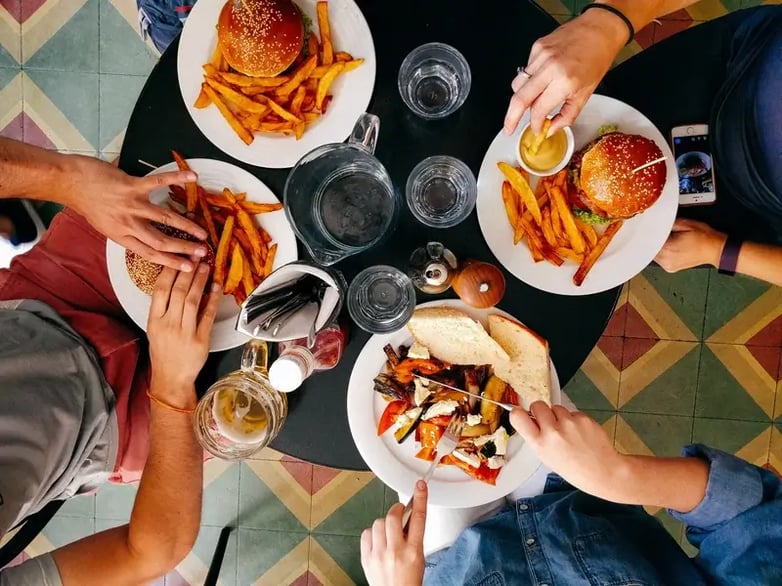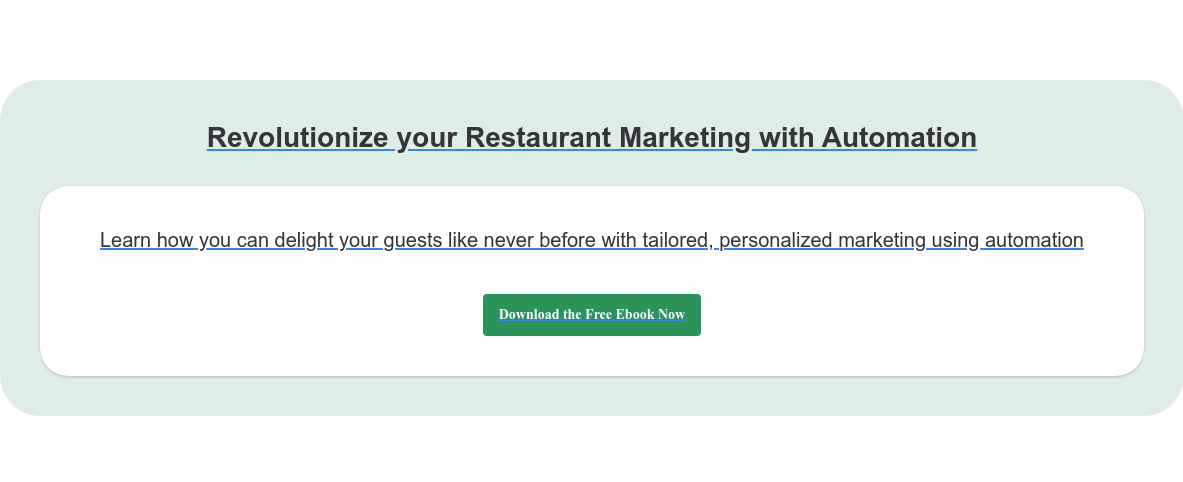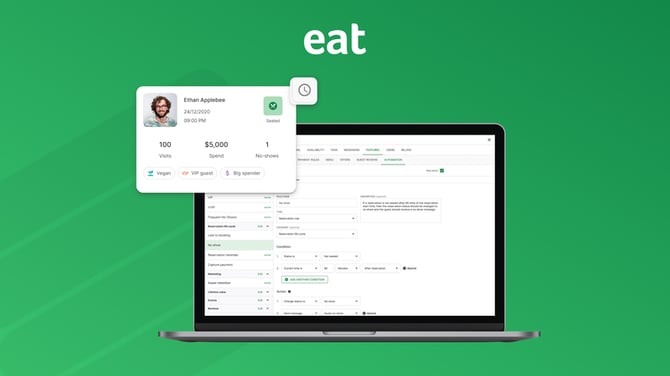The average restaurant operator spends well over 10 hours a day making sure their restaurant is running like clockwork. Most of that time is spent performing routine tasks that are essential to keep the business afloat but don't achieve much else. Restaurants would much rather have their operators focus on high level strategies that help drive business, increase revenue and improve operations instead of burning their time & resources on these repetitive tasks.
Zooming out a little bit, the components of this "high level strategy" ultimately form what restrateurs refer to as the guest loop or cycle of service - and optimizing that loop is the quickest way to efficiency at your restaurant.
When you can address these key points and find ways to save hours - you are streamlining operations and helping get one step closer to efficiency.
So what is the guest loop?
The guest loops starts by attracting customers (marketing), providing them with a seamless guest experience and then learning from that experience in a way that helps you bring them back in again (retention and loyalty)
Automation helps your restaurant become more efficient by plugging right into that loop and optimizing various daily processes like updating reservations, sending targeted messaging, and even the way you personalize the guest experience.
Let's break down some of the ways restaurant automation can help you optimize efficiency at your restaurant.
1. Spend less time on marketing
One of the most challenging tasks restaurants have to maintain on a daily basis is marketing their brand. After all, without trying to drive more customers to discover your restaurant, there is little to no possibility of growing your revenue.
-2.webp?width=782&height=519&name=restaurant%20marketing%20%20(1)-2.webp)
Some restaurants use paid advertising and social media to promote their brands - which is definitely essential in 2021. But a much more impactful approach to restaurant marketing is using your own guest database to email guests and get them to come back. It's easy to get a guest to visit your restaurant once, but getting them to come back multiple times - that's exponentially harder.
That's why getting personalized marketing right is so important. Restaurants that use automation can take advantage of personalized marketing without having to lift a finger.
Instead of spending hours every week putting together emails and lists, restaurant automation allows you to define rules and then have emails sent out on the regular to engage customers in ways your restaurant was never able to before.
Not only can you send out the traditional birthday and anniversary messages, but you can also start to send out more nuanced marketing like emailing guests when they hit a certain number of visits or spend a certain amount of money at your restaurant - of course, all heavily personalized to never lose that human touch.
This frees up hours of time for both you and your staff to take a more strategic approach to marketing. What content gets put into your marketing emails? Who should they go to? When should they get sent? Rather than worrying about the actual execution of each task.
2. Spend less time managing reservations
Reservation management is arguably one of the most important and repetitive tasks restaurant operators have to deal with daily. On one hand, it could be the single best source of revenue for your restaurant, but on the other hand, it could also be the single most inefficient sector of your operations.
-2.webp?width=782&height=663&name=Managing%20reservations%20%20(1)-2.webp)
Having to call guests every day to make sure they are still coming isn't going anywhere. If anything, we encourage you to spend most of your time trying to make your guest experience memorable - and that includes human touches like follow-up calls. But what restaurant automation aims to help curb are the hours of accumulated time spent updating reservations post-service - keeping track of which guests showed up, which didn't, and which you need to charge deposits for.
At the end of the day, managing reservations is one part guest experience and one part bookkeeping - automation aims to take care of the latter. This is achieved by automating the process of marking reservations as no-shows if the guest never arrives, updating the status to late if a guest isn't on time - and this can even feed into tagging guests, so if they book again - you know to expect them to be late or never arrive.
With more time freed up from chasing guests, your front-of-house and even servers can have more time to spend creating memorable guest experiences while building valuable and accurate reservation data in the background.
3. Reduce no-shows and secure payments
Automation makes no-shows a problem of the past. Ask any restaurant operator what their least favorite task is and 9 out of 10 times it's having to chase after guests to find out if they're going to make it to their reservation, and remembering to manually charge them with a deposit if they don't arrive.
-2.webp?width=782&height=521&name=Reduce%20No-Shows%20and%20Secure%20Payments%20(1)-2.webp) With restaurant automation, that's all taken care of without you or your staff ever having to lift a finger. Setting up automation rules makes it easier than ever to not only update reservations to no-show when a guest doesn't arrive but also helps you secure revenue seamlessly by automatically charging their card for the deposit amount when they turn into no-shows.
With restaurant automation, that's all taken care of without you or your staff ever having to lift a finger. Setting up automation rules makes it easier than ever to not only update reservations to no-show when a guest doesn't arrive but also helps you secure revenue seamlessly by automatically charging their card for the deposit amount when they turn into no-shows.
While having that revenue secured and taken care of is nice, you might not be super excited about no-shows in the first place, which is another way automation can help. Automated reminders keep guests from forgetting about bookings and help cut no-show rates at your restaurant drastically.
4. Improve loyalty and retention
Turning one-time diners to repeat customers is difficult. However, it's the key to increasing your restaurant's revenue. Automation makes this tedious task easy by helping your staff know everything about a guest from the moment they book their first reservation (like their preferences, spending habits, and last visit) through automated tagging. Through automation, your system auto-tags guests in the background based on a customized set of conditions that you are in full control of - making sure guest details are always updated and enabling your staff to provide a highly-personalized guest experience.

Automation also supercharges the data you can collect about your guests. Instead of relying on taking guest notes manually, let automation work in the background to tell you who your guests are and what they like, and use this data to run highly personalized, targeted marketing campaigns based on their preferences to get them to come back.
5. Improve reporting
Your reporting will never be the same once you let automation take over. Start building meaningful data that puts your restaurant performance right into your hands and makes it actionable. This means that at the end of a busy week or month, you can look back at what went right and what went wrong without ever having to question if the data is accurate.
Guest reports suddenly become so much more meaningful when you have data like guest preferences, spend and their dining experience charted for you in easy-to-understand tables and graphs.
-2.webp?width=600&height=496&name=Improve%20your%20stats%20(1)-2.webp)
This means you can start to make impactful decisions based on the data that helps you grow revenue and pinpoint areas in the guest experience where you can improve.
This article barely scratches the surface of what is possible with the right restaurant automation software for your business. The video below highlights more of what is possible with Eat App's restaurant automation.
Watch the video here.
Whether your goal is to streamline the reservation process, reduce no-shows or only to improve your marketing efforts - restaurant automation can plug right in and take over where it matters.
Learn more about Eat App's restaurant automation suite and schedule your free demo today ->














.webp?width=200&name=v2-15mknc-qpw1b%20(1).webp)
.webp?width=200&name=v2-15kqni-p0exl%20(1).webp)
-1.png?width=1812&height=1072&name=TripAdvisor%20%26%20More%20Bookings%20(1)-1.png)
-2.png?width=1812&height=1072&name=Google%20Bookings%20(1)-2.png)


-1.png?width=200&name=TripAdvisor%20%26%20More%20Bookings%20(1)-1.png)
-2.png?width=200&name=Google%20Bookings%20(1)-2.png)
-1.png?width=200&name=Instagram%20Bookings%20(1)-1.png)
-1-png.webp?width=200&name=Facebook%20Integration%20Rectangle%20(1)-1-png.webp)







.webp?width=200&name=download%20(1).webp)
%20(1)-2.webp?width=200&name=Eat%20(34)%20(1)-2.webp)
%20(1)-2.webp?width=200&name=Eat%20(18)%20(1)-2.webp)









.webp?width=314&height=175&name=Chit%20Printer%20Banner%20(8).webp)



.webp?width=144&height=72&name=Eat%20App%20Logo%20(3).webp)